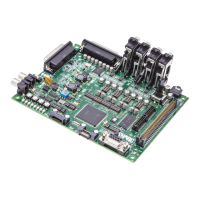Notation Conventions
lxx ADSP-214xx SHARC Processor Hardware Reference
Notation Conventions
Text conventions used in this manual are identified and described as fol-
lows. Note that additional conventions, which apply only to specific
chapters, may appear throughout this document.
Example Description
Close command
(File menu)
Titles in reference sections indicate the location of an item within the
VisualDSP++ environment’s menu system (for example, the Close com-
mand appears on the File menu).
{this | that} Alternative items in syntax descriptions appear within curly brackets
and separated by vertical bars; read the example as this or that. One
or the other is required.
[this | that] Optional items in syntax descriptions appear within brackets and sepa-
rated by vertical bars; read the example as an optional this or that.
[this,…] Optional item lists in syntax descriptions appear within brackets delim-
ited by commas and terminated with an ellipse; read the example as an
optional comma-separated list of this.
.
SECTION Commands, directives, keywords, and feature names are in text with
letter gothic font.
filename Non-keyword placeholders appear in text with italic style format.
SWRST Software Reset
register
Register names appear in UPPERCASE and a
special typeface. The
descriptive names of registers are in mixed case and regular typeface.
TMR0E, RESET Pin names appear in UPPERCASE and a special typeface.
Active low signals appear with an
OVERBAR.
DRx, I[3:0]
SMS[3:0]
Register, bit, and pin names in the text may refer to groups of registers
or pins:
A lowercase x in a register name (
DRx) indicates a set of registers (for
example,
DR2, DR1, and DR0).
A colon between numbers within brackets indicates a range of registers
or pins (for example,
I[3:0] indicates I3, I2, I1, and I0; SMS[3:0]
indicates
SMS3, SMS2, SMS1, and SMS0).
0xabcd, b#1111 A 0x prefix indicates hexadecimal; a b# prefix indicates binary.

